Teacher Librarian Report: Cross-Curriculum Priorities in Schools
VerifiedAdded on 2023/04/06
|12
|2946
|81
Report
AI Summary
This report, titled "TEACHER LIBRARIAN," examines the evolving role of teacher librarians in schools, particularly concerning the integration of physical and digital resources. It contrasts physical books with e-books, highlighting the advantages and disadvantages of each format, while emphasizing the importance of school libraries in fostering reading habits and promoting cross-cultural understanding. The report delves into cross-curricular teaching methods, emphasizing their effectiveness in developing problem-solving skills and engaging students. It then outlines the collection development process, including resource selection and evaluation, and stresses the importance of including diverse materials to enhance students' knowledge and cultural awareness. The annotated bibliography provides summaries of key articles related to the Australian curriculum's cross-curriculum priorities, focusing on Asia literacy and sustainability. The report highlights the critical need for high-level institutional guidance and teacher support to ensure the successful implementation of these priorities, ultimately aiming to equip students with the skills and knowledge necessary for global citizenship and environmental responsibility.
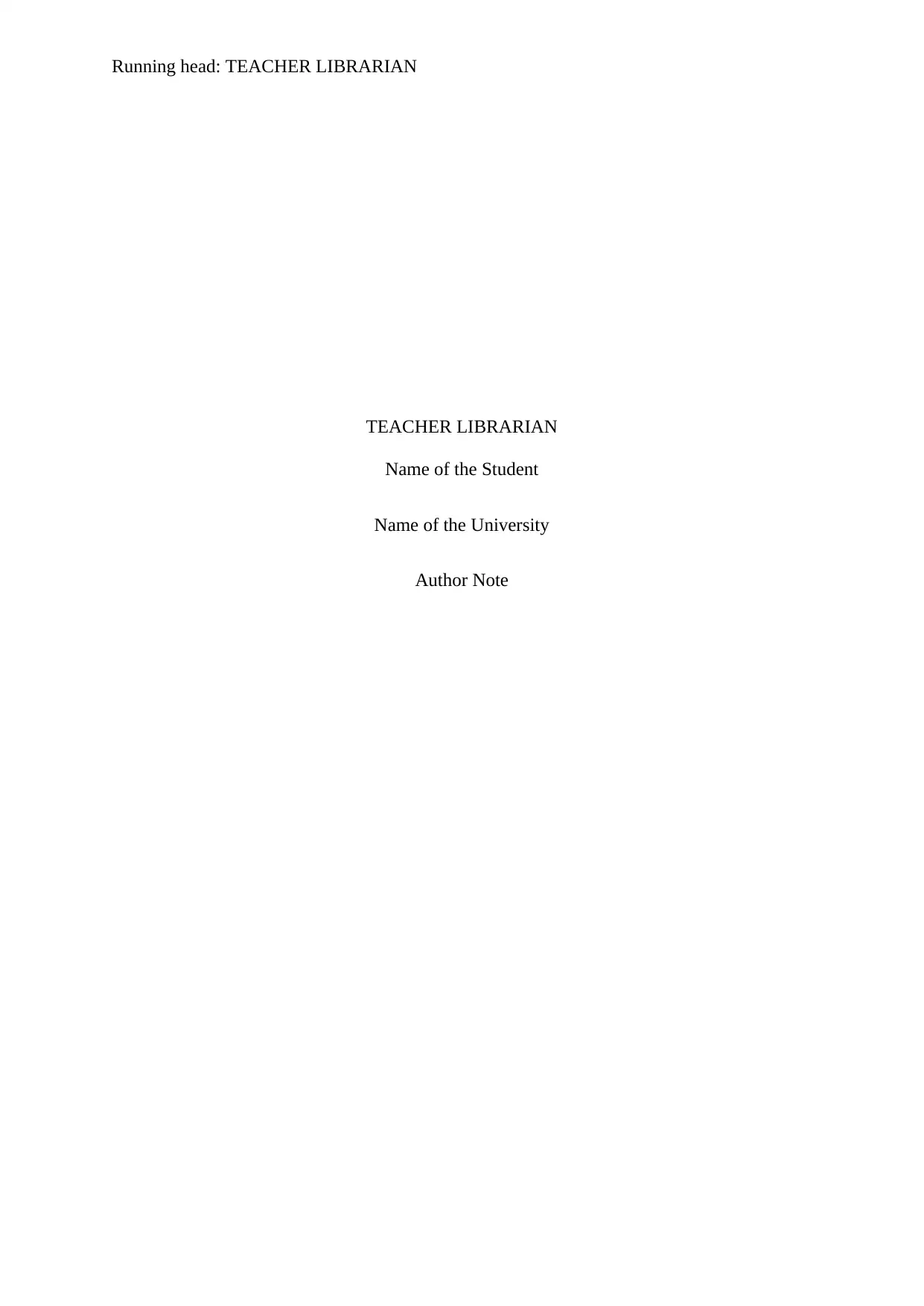
Running head: TEACHER LIBRARIAN
TEACHER LIBRARIAN
Name of the Student
Name of the University
Author Note
TEACHER LIBRARIAN
Name of the Student
Name of the University
Author Note
Paraphrase This Document
Need a fresh take? Get an instant paraphrase of this document with our AI Paraphraser
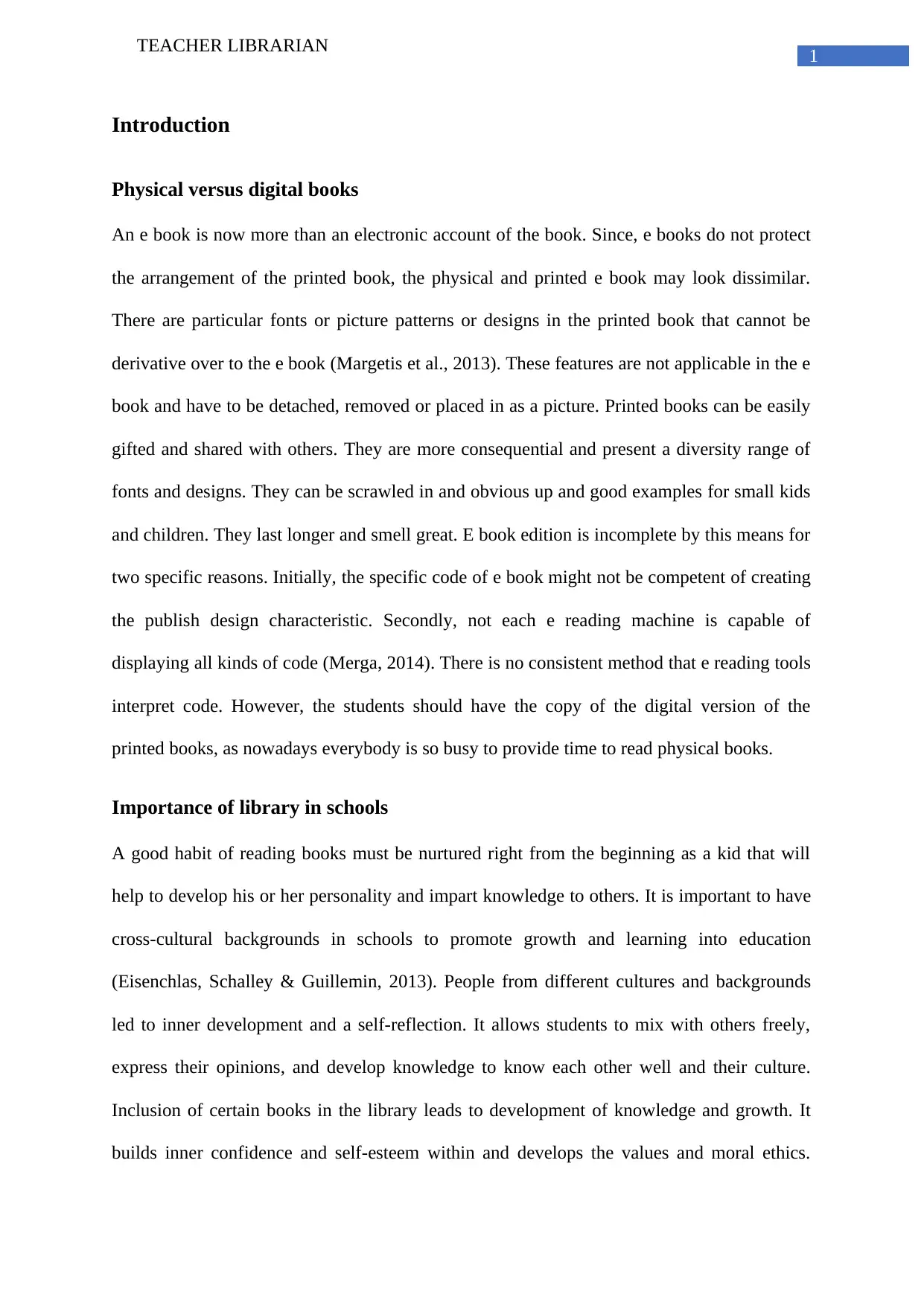
1
TEACHER LIBRARIAN
Introduction
Physical versus digital books
An e book is now more than an electronic account of the book. Since, e books do not protect
the arrangement of the printed book, the physical and printed e book may look dissimilar.
There are particular fonts or picture patterns or designs in the printed book that cannot be
derivative over to the e book (Margetis et al., 2013). These features are not applicable in the e
book and have to be detached, removed or placed in as a picture. Printed books can be easily
gifted and shared with others. They are more consequential and present a diversity range of
fonts and designs. They can be scrawled in and obvious up and good examples for small kids
and children. They last longer and smell great. E book edition is incomplete by this means for
two specific reasons. Initially, the specific code of e book might not be competent of creating
the publish design characteristic. Secondly, not each e reading machine is capable of
displaying all kinds of code (Merga, 2014). There is no consistent method that e reading tools
interpret code. However, the students should have the copy of the digital version of the
printed books, as nowadays everybody is so busy to provide time to read physical books.
Importance of library in schools
A good habit of reading books must be nurtured right from the beginning as a kid that will
help to develop his or her personality and impart knowledge to others. It is important to have
cross-cultural backgrounds in schools to promote growth and learning into education
(Eisenchlas, Schalley & Guillemin, 2013). People from different cultures and backgrounds
led to inner development and a self-reflection. It allows students to mix with others freely,
express their opinions, and develop knowledge to know each other well and their culture.
Inclusion of certain books in the library leads to development of knowledge and growth. It
builds inner confidence and self-esteem within and develops the values and moral ethics.
TEACHER LIBRARIAN
Introduction
Physical versus digital books
An e book is now more than an electronic account of the book. Since, e books do not protect
the arrangement of the printed book, the physical and printed e book may look dissimilar.
There are particular fonts or picture patterns or designs in the printed book that cannot be
derivative over to the e book (Margetis et al., 2013). These features are not applicable in the e
book and have to be detached, removed or placed in as a picture. Printed books can be easily
gifted and shared with others. They are more consequential and present a diversity range of
fonts and designs. They can be scrawled in and obvious up and good examples for small kids
and children. They last longer and smell great. E book edition is incomplete by this means for
two specific reasons. Initially, the specific code of e book might not be competent of creating
the publish design characteristic. Secondly, not each e reading machine is capable of
displaying all kinds of code (Merga, 2014). There is no consistent method that e reading tools
interpret code. However, the students should have the copy of the digital version of the
printed books, as nowadays everybody is so busy to provide time to read physical books.
Importance of library in schools
A good habit of reading books must be nurtured right from the beginning as a kid that will
help to develop his or her personality and impart knowledge to others. It is important to have
cross-cultural backgrounds in schools to promote growth and learning into education
(Eisenchlas, Schalley & Guillemin, 2013). People from different cultures and backgrounds
led to inner development and a self-reflection. It allows students to mix with others freely,
express their opinions, and develop knowledge to know each other well and their culture.
Inclusion of certain books in the library leads to development of knowledge and growth. It
builds inner confidence and self-esteem within and develops the values and moral ethics.
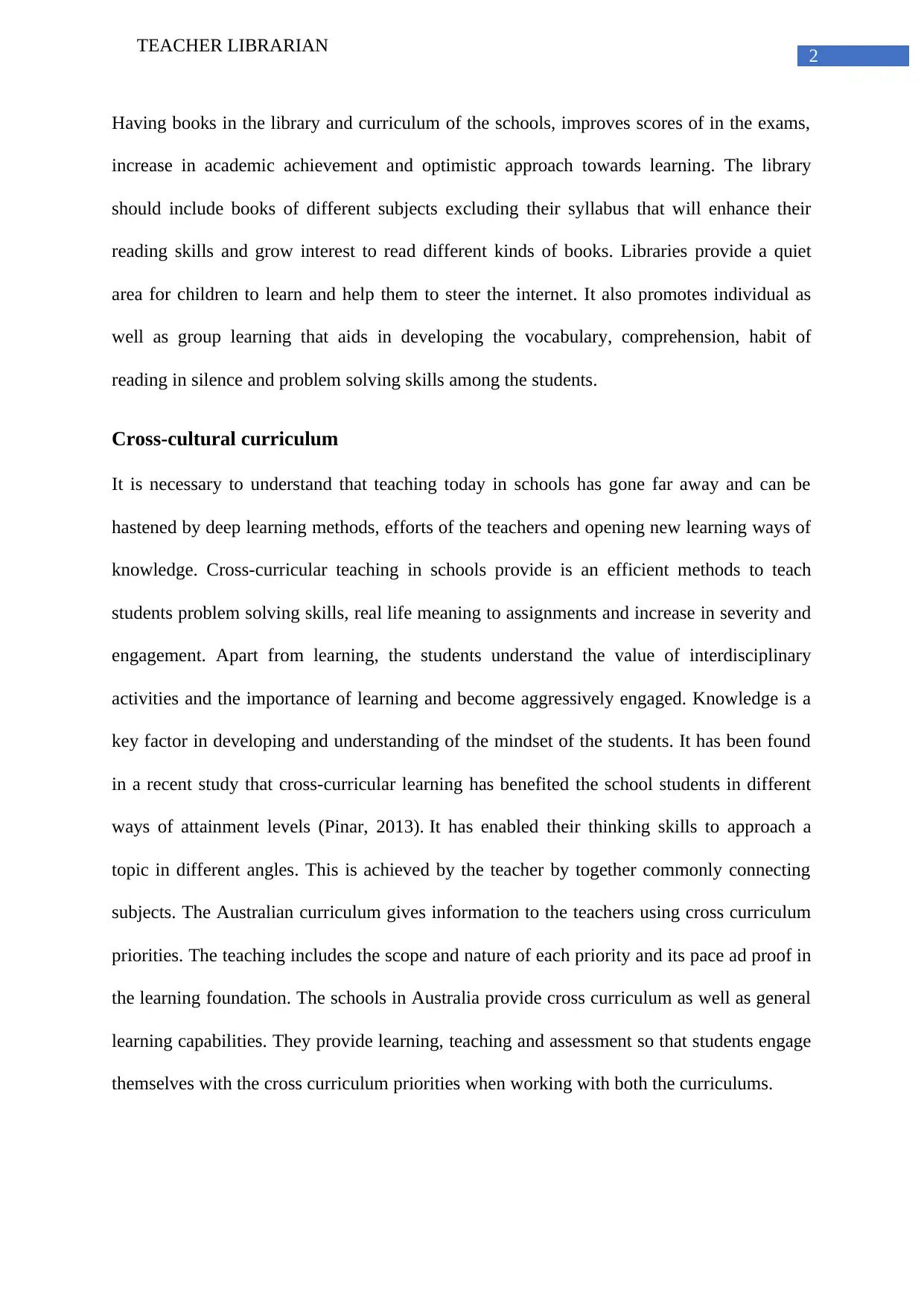
2
TEACHER LIBRARIAN
Having books in the library and curriculum of the schools, improves scores of in the exams,
increase in academic achievement and optimistic approach towards learning. The library
should include books of different subjects excluding their syllabus that will enhance their
reading skills and grow interest to read different kinds of books. Libraries provide a quiet
area for children to learn and help them to steer the internet. It also promotes individual as
well as group learning that aids in developing the vocabulary, comprehension, habit of
reading in silence and problem solving skills among the students.
Cross-cultural curriculum
It is necessary to understand that teaching today in schools has gone far away and can be
hastened by deep learning methods, efforts of the teachers and opening new learning ways of
knowledge. Cross-curricular teaching in schools provide is an efficient methods to teach
students problem solving skills, real life meaning to assignments and increase in severity and
engagement. Apart from learning, the students understand the value of interdisciplinary
activities and the importance of learning and become aggressively engaged. Knowledge is a
key factor in developing and understanding of the mindset of the students. It has been found
in a recent study that cross-curricular learning has benefited the school students in different
ways of attainment levels (Pinar, 2013). It has enabled their thinking skills to approach a
topic in different angles. This is achieved by the teacher by together commonly connecting
subjects. The Australian curriculum gives information to the teachers using cross curriculum
priorities. The teaching includes the scope and nature of each priority and its pace ad proof in
the learning foundation. The schools in Australia provide cross curriculum as well as general
learning capabilities. They provide learning, teaching and assessment so that students engage
themselves with the cross curriculum priorities when working with both the curriculums.
TEACHER LIBRARIAN
Having books in the library and curriculum of the schools, improves scores of in the exams,
increase in academic achievement and optimistic approach towards learning. The library
should include books of different subjects excluding their syllabus that will enhance their
reading skills and grow interest to read different kinds of books. Libraries provide a quiet
area for children to learn and help them to steer the internet. It also promotes individual as
well as group learning that aids in developing the vocabulary, comprehension, habit of
reading in silence and problem solving skills among the students.
Cross-cultural curriculum
It is necessary to understand that teaching today in schools has gone far away and can be
hastened by deep learning methods, efforts of the teachers and opening new learning ways of
knowledge. Cross-curricular teaching in schools provide is an efficient methods to teach
students problem solving skills, real life meaning to assignments and increase in severity and
engagement. Apart from learning, the students understand the value of interdisciplinary
activities and the importance of learning and become aggressively engaged. Knowledge is a
key factor in developing and understanding of the mindset of the students. It has been found
in a recent study that cross-curricular learning has benefited the school students in different
ways of attainment levels (Pinar, 2013). It has enabled their thinking skills to approach a
topic in different angles. This is achieved by the teacher by together commonly connecting
subjects. The Australian curriculum gives information to the teachers using cross curriculum
priorities. The teaching includes the scope and nature of each priority and its pace ad proof in
the learning foundation. The schools in Australia provide cross curriculum as well as general
learning capabilities. They provide learning, teaching and assessment so that students engage
themselves with the cross curriculum priorities when working with both the curriculums.
⊘ This is a preview!⊘
Do you want full access?
Subscribe today to unlock all pages.

Trusted by 1+ million students worldwide
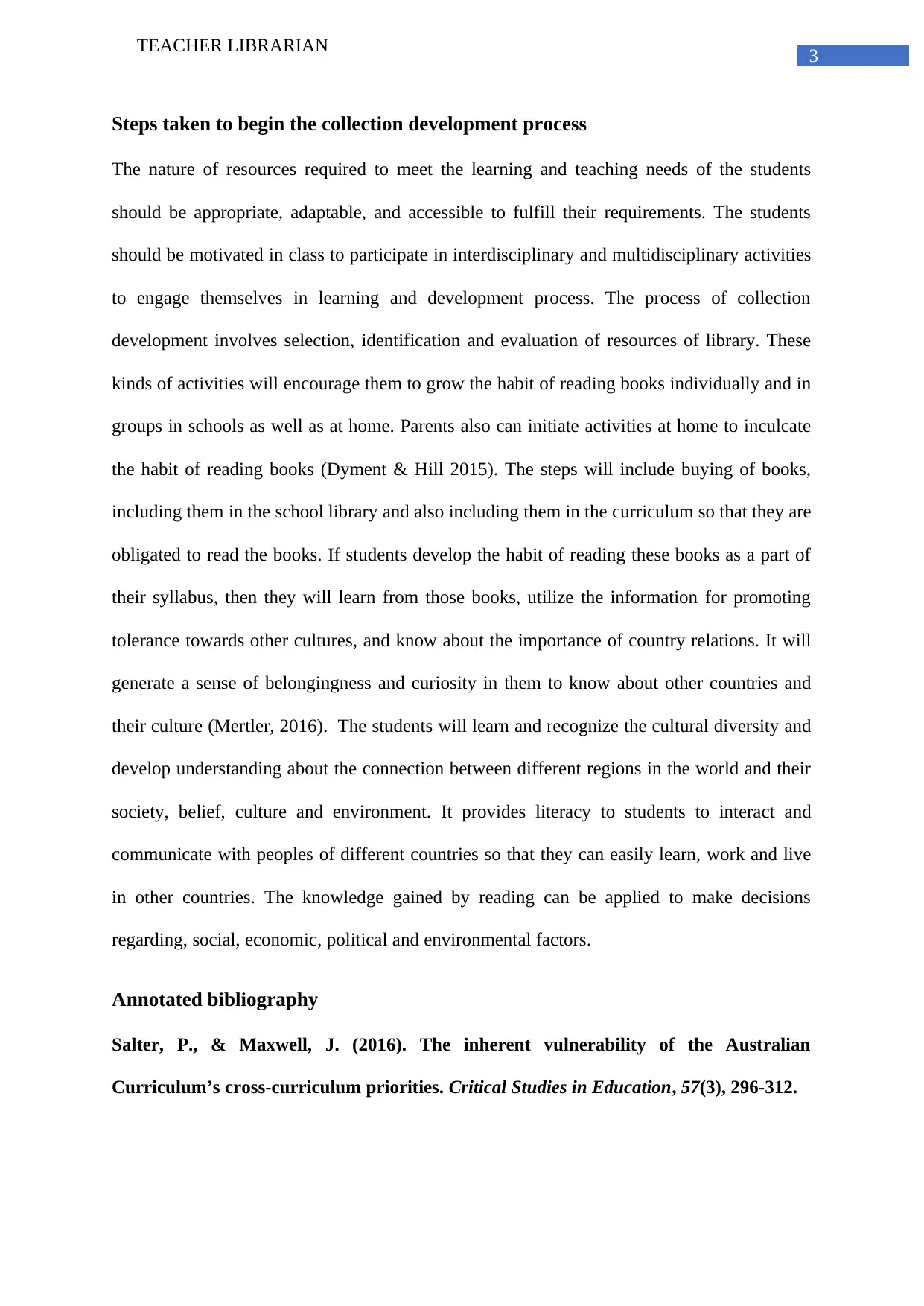
3
TEACHER LIBRARIAN
Steps taken to begin the collection development process
The nature of resources required to meet the learning and teaching needs of the students
should be appropriate, adaptable, and accessible to fulfill their requirements. The students
should be motivated in class to participate in interdisciplinary and multidisciplinary activities
to engage themselves in learning and development process. The process of collection
development involves selection, identification and evaluation of resources of library. These
kinds of activities will encourage them to grow the habit of reading books individually and in
groups in schools as well as at home. Parents also can initiate activities at home to inculcate
the habit of reading books (Dyment & Hill 2015). The steps will include buying of books,
including them in the school library and also including them in the curriculum so that they are
obligated to read the books. If students develop the habit of reading these books as a part of
their syllabus, then they will learn from those books, utilize the information for promoting
tolerance towards other cultures, and know about the importance of country relations. It will
generate a sense of belongingness and curiosity in them to know about other countries and
their culture (Mertler, 2016). The students will learn and recognize the cultural diversity and
develop understanding about the connection between different regions in the world and their
society, belief, culture and environment. It provides literacy to students to interact and
communicate with peoples of different countries so that they can easily learn, work and live
in other countries. The knowledge gained by reading can be applied to make decisions
regarding, social, economic, political and environmental factors.
Annotated bibliography
Salter, P., & Maxwell, J. (2016). The inherent vulnerability of the Australian
Curriculum’s cross-curriculum priorities. Critical Studies in Education, 57(3), 296-312.
TEACHER LIBRARIAN
Steps taken to begin the collection development process
The nature of resources required to meet the learning and teaching needs of the students
should be appropriate, adaptable, and accessible to fulfill their requirements. The students
should be motivated in class to participate in interdisciplinary and multidisciplinary activities
to engage themselves in learning and development process. The process of collection
development involves selection, identification and evaluation of resources of library. These
kinds of activities will encourage them to grow the habit of reading books individually and in
groups in schools as well as at home. Parents also can initiate activities at home to inculcate
the habit of reading books (Dyment & Hill 2015). The steps will include buying of books,
including them in the school library and also including them in the curriculum so that they are
obligated to read the books. If students develop the habit of reading these books as a part of
their syllabus, then they will learn from those books, utilize the information for promoting
tolerance towards other cultures, and know about the importance of country relations. It will
generate a sense of belongingness and curiosity in them to know about other countries and
their culture (Mertler, 2016). The students will learn and recognize the cultural diversity and
develop understanding about the connection between different regions in the world and their
society, belief, culture and environment. It provides literacy to students to interact and
communicate with peoples of different countries so that they can easily learn, work and live
in other countries. The knowledge gained by reading can be applied to make decisions
regarding, social, economic, political and environmental factors.
Annotated bibliography
Salter, P., & Maxwell, J. (2016). The inherent vulnerability of the Australian
Curriculum’s cross-curriculum priorities. Critical Studies in Education, 57(3), 296-312.
Paraphrase This Document
Need a fresh take? Get an instant paraphrase of this document with our AI Paraphraser
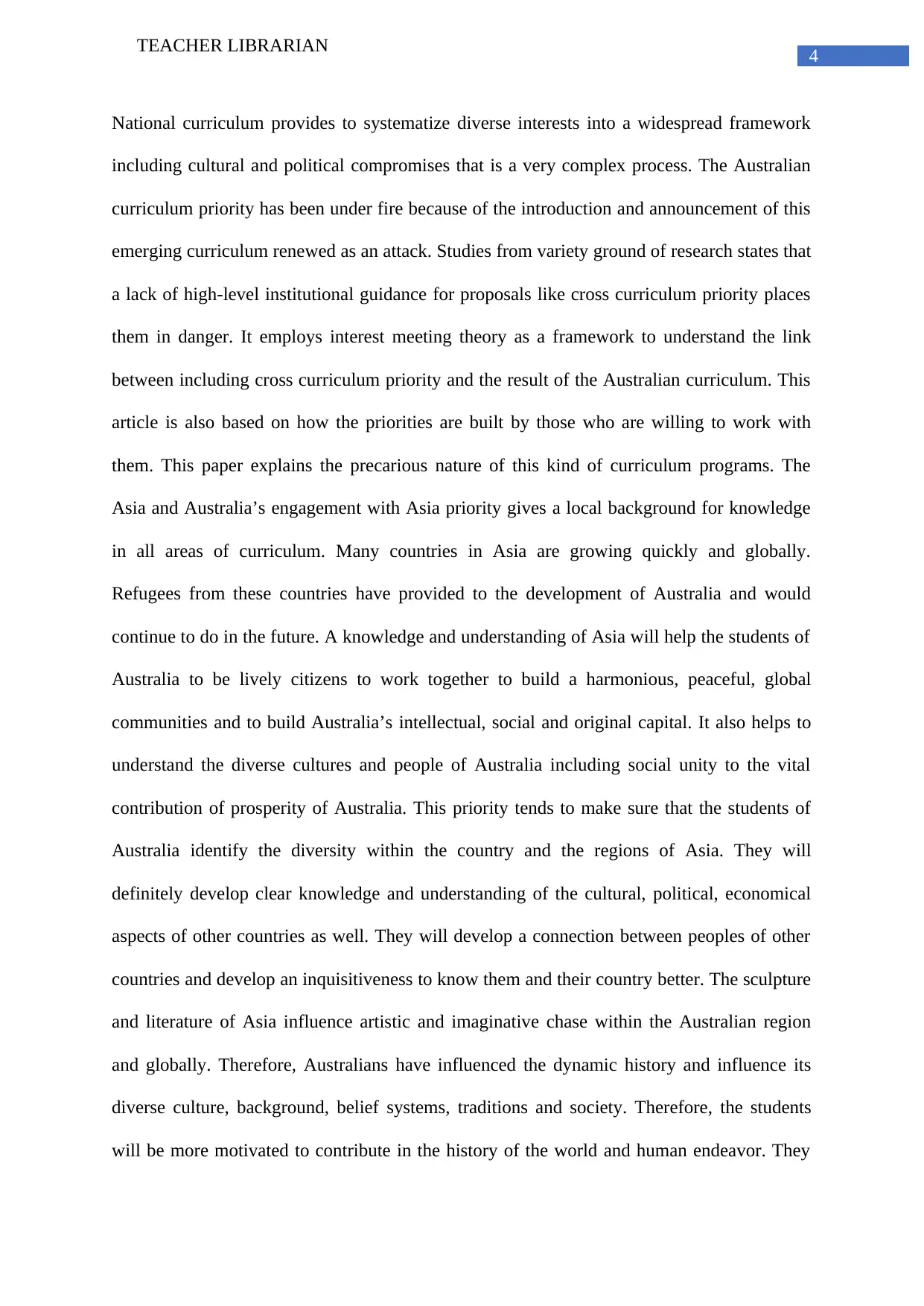
4
TEACHER LIBRARIAN
National curriculum provides to systematize diverse interests into a widespread framework
including cultural and political compromises that is a very complex process. The Australian
curriculum priority has been under fire because of the introduction and announcement of this
emerging curriculum renewed as an attack. Studies from variety ground of research states that
a lack of high-level institutional guidance for proposals like cross curriculum priority places
them in danger. It employs interest meeting theory as a framework to understand the link
between including cross curriculum priority and the result of the Australian curriculum. This
article is also based on how the priorities are built by those who are willing to work with
them. This paper explains the precarious nature of this kind of curriculum programs. The
Asia and Australia’s engagement with Asia priority gives a local background for knowledge
in all areas of curriculum. Many countries in Asia are growing quickly and globally.
Refugees from these countries have provided to the development of Australia and would
continue to do in the future. A knowledge and understanding of Asia will help the students of
Australia to be lively citizens to work together to build a harmonious, peaceful, global
communities and to build Australia’s intellectual, social and original capital. It also helps to
understand the diverse cultures and people of Australia including social unity to the vital
contribution of prosperity of Australia. This priority tends to make sure that the students of
Australia identify the diversity within the country and the regions of Asia. They will
definitely develop clear knowledge and understanding of the cultural, political, economical
aspects of other countries as well. They will develop a connection between peoples of other
countries and develop an inquisitiveness to know them and their country better. The sculpture
and literature of Asia influence artistic and imaginative chase within the Australian region
and globally. Therefore, Australians have influenced the dynamic history and influence its
diverse culture, background, belief systems, traditions and society. Therefore, the students
will be more motivated to contribute in the history of the world and human endeavor. They
TEACHER LIBRARIAN
National curriculum provides to systematize diverse interests into a widespread framework
including cultural and political compromises that is a very complex process. The Australian
curriculum priority has been under fire because of the introduction and announcement of this
emerging curriculum renewed as an attack. Studies from variety ground of research states that
a lack of high-level institutional guidance for proposals like cross curriculum priority places
them in danger. It employs interest meeting theory as a framework to understand the link
between including cross curriculum priority and the result of the Australian curriculum. This
article is also based on how the priorities are built by those who are willing to work with
them. This paper explains the precarious nature of this kind of curriculum programs. The
Asia and Australia’s engagement with Asia priority gives a local background for knowledge
in all areas of curriculum. Many countries in Asia are growing quickly and globally.
Refugees from these countries have provided to the development of Australia and would
continue to do in the future. A knowledge and understanding of Asia will help the students of
Australia to be lively citizens to work together to build a harmonious, peaceful, global
communities and to build Australia’s intellectual, social and original capital. It also helps to
understand the diverse cultures and people of Australia including social unity to the vital
contribution of prosperity of Australia. This priority tends to make sure that the students of
Australia identify the diversity within the country and the regions of Asia. They will
definitely develop clear knowledge and understanding of the cultural, political, economical
aspects of other countries as well. They will develop a connection between peoples of other
countries and develop an inquisitiveness to know them and their country better. The sculpture
and literature of Asia influence artistic and imaginative chase within the Australian region
and globally. Therefore, Australians have influenced the dynamic history and influence its
diverse culture, background, belief systems, traditions and society. Therefore, the students
will be more motivated to contribute in the history of the world and human endeavor. They
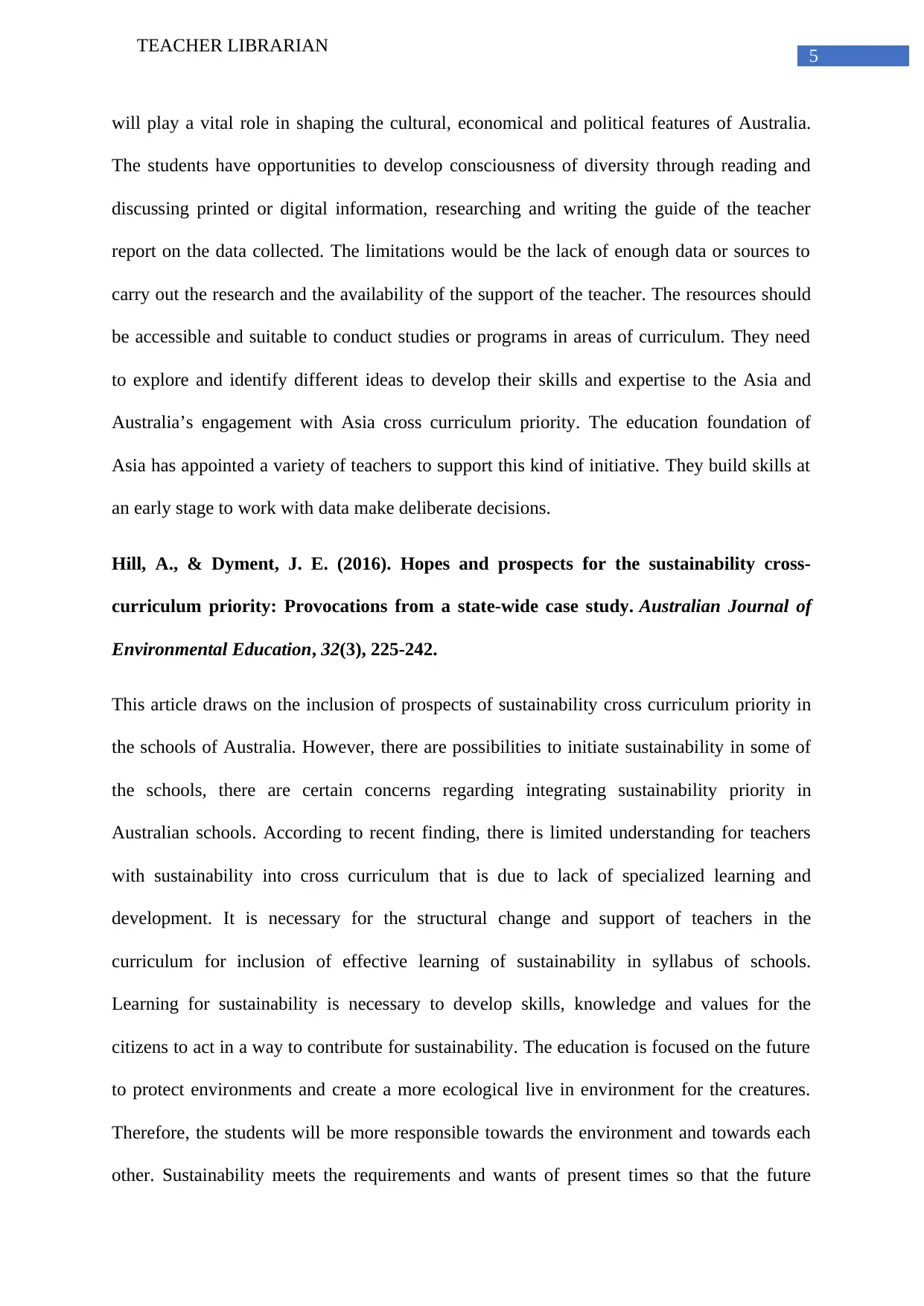
5
TEACHER LIBRARIAN
will play a vital role in shaping the cultural, economical and political features of Australia.
The students have opportunities to develop consciousness of diversity through reading and
discussing printed or digital information, researching and writing the guide of the teacher
report on the data collected. The limitations would be the lack of enough data or sources to
carry out the research and the availability of the support of the teacher. The resources should
be accessible and suitable to conduct studies or programs in areas of curriculum. They need
to explore and identify different ideas to develop their skills and expertise to the Asia and
Australia’s engagement with Asia cross curriculum priority. The education foundation of
Asia has appointed a variety of teachers to support this kind of initiative. They build skills at
an early stage to work with data make deliberate decisions.
Hill, A., & Dyment, J. E. (2016). Hopes and prospects for the sustainability cross-
curriculum priority: Provocations from a state-wide case study. Australian Journal of
Environmental Education, 32(3), 225-242.
This article draws on the inclusion of prospects of sustainability cross curriculum priority in
the schools of Australia. However, there are possibilities to initiate sustainability in some of
the schools, there are certain concerns regarding integrating sustainability priority in
Australian schools. According to recent finding, there is limited understanding for teachers
with sustainability into cross curriculum that is due to lack of specialized learning and
development. It is necessary for the structural change and support of teachers in the
curriculum for inclusion of effective learning of sustainability in syllabus of schools.
Learning for sustainability is necessary to develop skills, knowledge and values for the
citizens to act in a way to contribute for sustainability. The education is focused on the future
to protect environments and create a more ecological live in environment for the creatures.
Therefore, the students will be more responsible towards the environment and towards each
other. Sustainability meets the requirements and wants of present times so that the future
TEACHER LIBRARIAN
will play a vital role in shaping the cultural, economical and political features of Australia.
The students have opportunities to develop consciousness of diversity through reading and
discussing printed or digital information, researching and writing the guide of the teacher
report on the data collected. The limitations would be the lack of enough data or sources to
carry out the research and the availability of the support of the teacher. The resources should
be accessible and suitable to conduct studies or programs in areas of curriculum. They need
to explore and identify different ideas to develop their skills and expertise to the Asia and
Australia’s engagement with Asia cross curriculum priority. The education foundation of
Asia has appointed a variety of teachers to support this kind of initiative. They build skills at
an early stage to work with data make deliberate decisions.
Hill, A., & Dyment, J. E. (2016). Hopes and prospects for the sustainability cross-
curriculum priority: Provocations from a state-wide case study. Australian Journal of
Environmental Education, 32(3), 225-242.
This article draws on the inclusion of prospects of sustainability cross curriculum priority in
the schools of Australia. However, there are possibilities to initiate sustainability in some of
the schools, there are certain concerns regarding integrating sustainability priority in
Australian schools. According to recent finding, there is limited understanding for teachers
with sustainability into cross curriculum that is due to lack of specialized learning and
development. It is necessary for the structural change and support of teachers in the
curriculum for inclusion of effective learning of sustainability in syllabus of schools.
Learning for sustainability is necessary to develop skills, knowledge and values for the
citizens to act in a way to contribute for sustainability. The education is focused on the future
to protect environments and create a more ecological live in environment for the creatures.
Therefore, the students will be more responsible towards the environment and towards each
other. Sustainability meets the requirements and wants of present times so that the future
⊘ This is a preview!⊘
Do you want full access?
Subscribe today to unlock all pages.

Trusted by 1+ million students worldwide
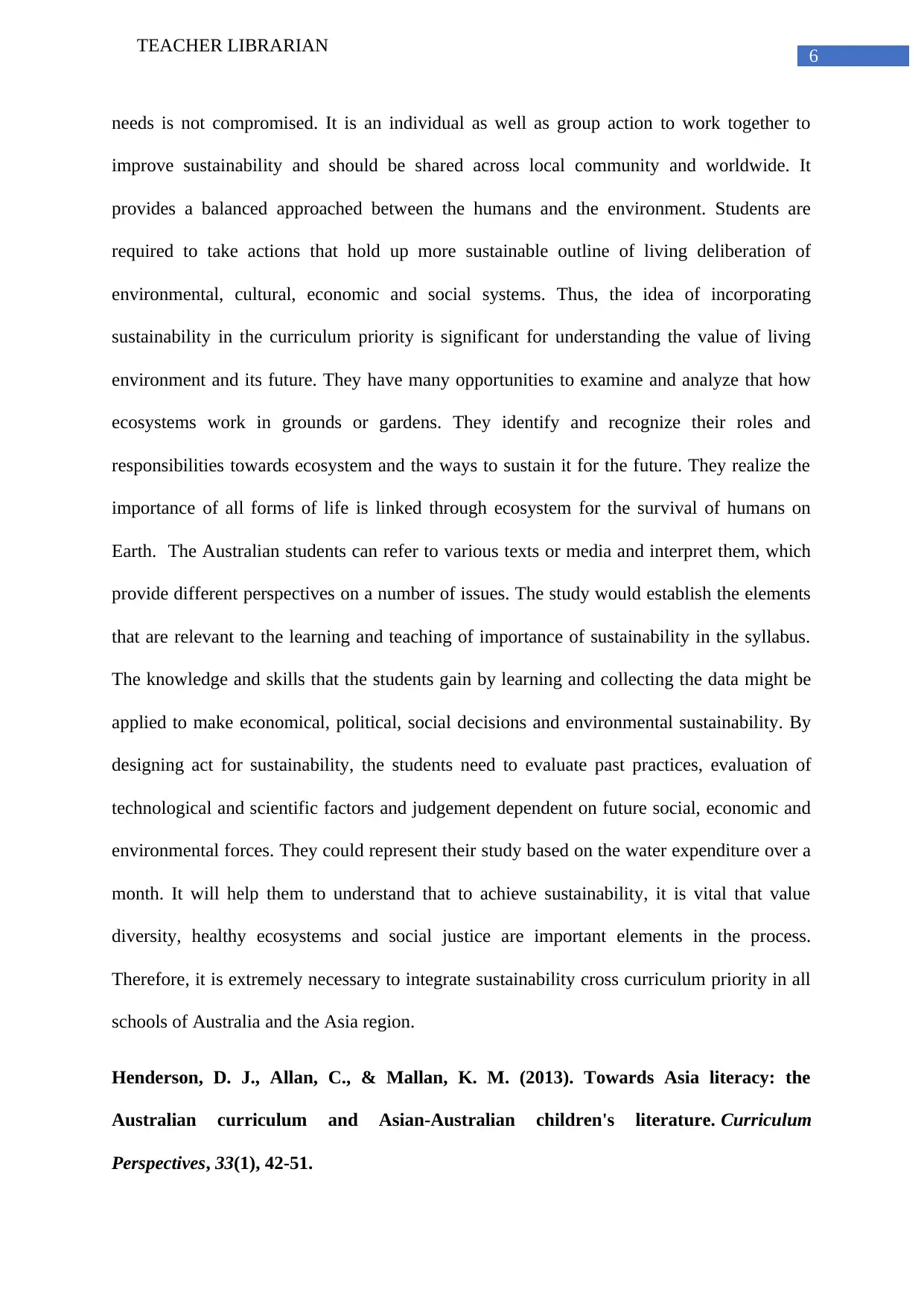
6
TEACHER LIBRARIAN
needs is not compromised. It is an individual as well as group action to work together to
improve sustainability and should be shared across local community and worldwide. It
provides a balanced approached between the humans and the environment. Students are
required to take actions that hold up more sustainable outline of living deliberation of
environmental, cultural, economic and social systems. Thus, the idea of incorporating
sustainability in the curriculum priority is significant for understanding the value of living
environment and its future. They have many opportunities to examine and analyze that how
ecosystems work in grounds or gardens. They identify and recognize their roles and
responsibilities towards ecosystem and the ways to sustain it for the future. They realize the
importance of all forms of life is linked through ecosystem for the survival of humans on
Earth. The Australian students can refer to various texts or media and interpret them, which
provide different perspectives on a number of issues. The study would establish the elements
that are relevant to the learning and teaching of importance of sustainability in the syllabus.
The knowledge and skills that the students gain by learning and collecting the data might be
applied to make economical, political, social decisions and environmental sustainability. By
designing act for sustainability, the students need to evaluate past practices, evaluation of
technological and scientific factors and judgement dependent on future social, economic and
environmental forces. They could represent their study based on the water expenditure over a
month. It will help them to understand that to achieve sustainability, it is vital that value
diversity, healthy ecosystems and social justice are important elements in the process.
Therefore, it is extremely necessary to integrate sustainability cross curriculum priority in all
schools of Australia and the Asia region.
Henderson, D. J., Allan, C., & Mallan, K. M. (2013). Towards Asia literacy: the
Australian curriculum and Asian-Australian children's literature. Curriculum
Perspectives, 33(1), 42-51.
TEACHER LIBRARIAN
needs is not compromised. It is an individual as well as group action to work together to
improve sustainability and should be shared across local community and worldwide. It
provides a balanced approached between the humans and the environment. Students are
required to take actions that hold up more sustainable outline of living deliberation of
environmental, cultural, economic and social systems. Thus, the idea of incorporating
sustainability in the curriculum priority is significant for understanding the value of living
environment and its future. They have many opportunities to examine and analyze that how
ecosystems work in grounds or gardens. They identify and recognize their roles and
responsibilities towards ecosystem and the ways to sustain it for the future. They realize the
importance of all forms of life is linked through ecosystem for the survival of humans on
Earth. The Australian students can refer to various texts or media and interpret them, which
provide different perspectives on a number of issues. The study would establish the elements
that are relevant to the learning and teaching of importance of sustainability in the syllabus.
The knowledge and skills that the students gain by learning and collecting the data might be
applied to make economical, political, social decisions and environmental sustainability. By
designing act for sustainability, the students need to evaluate past practices, evaluation of
technological and scientific factors and judgement dependent on future social, economic and
environmental forces. They could represent their study based on the water expenditure over a
month. It will help them to understand that to achieve sustainability, it is vital that value
diversity, healthy ecosystems and social justice are important elements in the process.
Therefore, it is extremely necessary to integrate sustainability cross curriculum priority in all
schools of Australia and the Asia region.
Henderson, D. J., Allan, C., & Mallan, K. M. (2013). Towards Asia literacy: the
Australian curriculum and Asian-Australian children's literature. Curriculum
Perspectives, 33(1), 42-51.
Paraphrase This Document
Need a fresh take? Get an instant paraphrase of this document with our AI Paraphraser
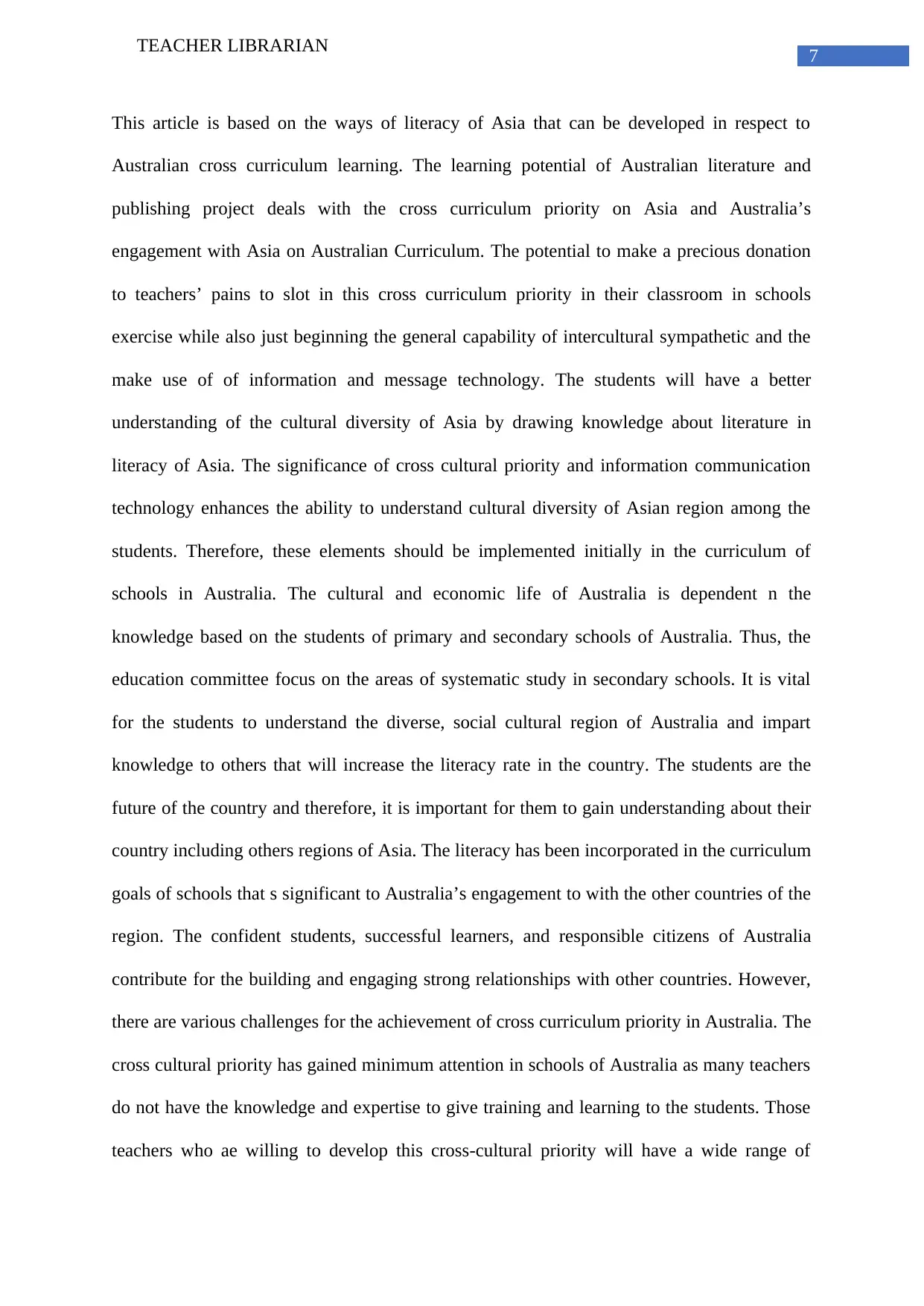
7
TEACHER LIBRARIAN
This article is based on the ways of literacy of Asia that can be developed in respect to
Australian cross curriculum learning. The learning potential of Australian literature and
publishing project deals with the cross curriculum priority on Asia and Australia’s
engagement with Asia on Australian Curriculum. The potential to make a precious donation
to teachers’ pains to slot in this cross curriculum priority in their classroom in schools
exercise while also just beginning the general capability of intercultural sympathetic and the
make use of of information and message technology. The students will have a better
understanding of the cultural diversity of Asia by drawing knowledge about literature in
literacy of Asia. The significance of cross cultural priority and information communication
technology enhances the ability to understand cultural diversity of Asian region among the
students. Therefore, these elements should be implemented initially in the curriculum of
schools in Australia. The cultural and economic life of Australia is dependent n the
knowledge based on the students of primary and secondary schools of Australia. Thus, the
education committee focus on the areas of systematic study in secondary schools. It is vital
for the students to understand the diverse, social cultural region of Australia and impart
knowledge to others that will increase the literacy rate in the country. The students are the
future of the country and therefore, it is important for them to gain understanding about their
country including others regions of Asia. The literacy has been incorporated in the curriculum
goals of schools that s significant to Australia’s engagement to with the other countries of the
region. The confident students, successful learners, and responsible citizens of Australia
contribute for the building and engaging strong relationships with other countries. However,
there are various challenges for the achievement of cross curriculum priority in Australia. The
cross cultural priority has gained minimum attention in schools of Australia as many teachers
do not have the knowledge and expertise to give training and learning to the students. Those
teachers who ae willing to develop this cross-cultural priority will have a wide range of
TEACHER LIBRARIAN
This article is based on the ways of literacy of Asia that can be developed in respect to
Australian cross curriculum learning. The learning potential of Australian literature and
publishing project deals with the cross curriculum priority on Asia and Australia’s
engagement with Asia on Australian Curriculum. The potential to make a precious donation
to teachers’ pains to slot in this cross curriculum priority in their classroom in schools
exercise while also just beginning the general capability of intercultural sympathetic and the
make use of of information and message technology. The students will have a better
understanding of the cultural diversity of Asia by drawing knowledge about literature in
literacy of Asia. The significance of cross cultural priority and information communication
technology enhances the ability to understand cultural diversity of Asian region among the
students. Therefore, these elements should be implemented initially in the curriculum of
schools in Australia. The cultural and economic life of Australia is dependent n the
knowledge based on the students of primary and secondary schools of Australia. Thus, the
education committee focus on the areas of systematic study in secondary schools. It is vital
for the students to understand the diverse, social cultural region of Australia and impart
knowledge to others that will increase the literacy rate in the country. The students are the
future of the country and therefore, it is important for them to gain understanding about their
country including others regions of Asia. The literacy has been incorporated in the curriculum
goals of schools that s significant to Australia’s engagement to with the other countries of the
region. The confident students, successful learners, and responsible citizens of Australia
contribute for the building and engaging strong relationships with other countries. However,
there are various challenges for the achievement of cross curriculum priority in Australia. The
cross cultural priority has gained minimum attention in schools of Australia as many teachers
do not have the knowledge and expertise to give training and learning to the students. Those
teachers who ae willing to develop this cross-cultural priority will have a wide range of
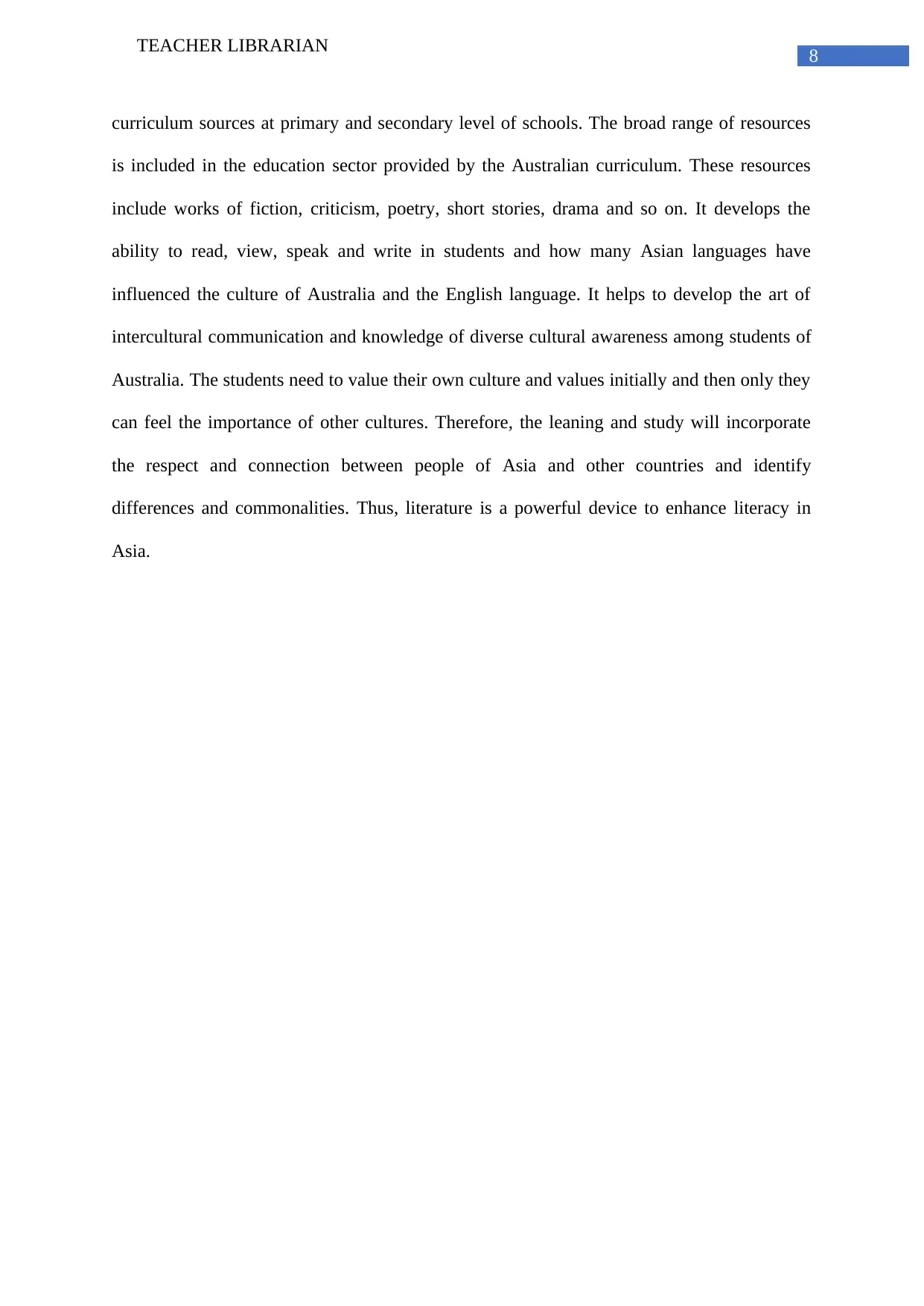
8
TEACHER LIBRARIAN
curriculum sources at primary and secondary level of schools. The broad range of resources
is included in the education sector provided by the Australian curriculum. These resources
include works of fiction, criticism, poetry, short stories, drama and so on. It develops the
ability to read, view, speak and write in students and how many Asian languages have
influenced the culture of Australia and the English language. It helps to develop the art of
intercultural communication and knowledge of diverse cultural awareness among students of
Australia. The students need to value their own culture and values initially and then only they
can feel the importance of other cultures. Therefore, the leaning and study will incorporate
the respect and connection between people of Asia and other countries and identify
differences and commonalities. Thus, literature is a powerful device to enhance literacy in
Asia.
TEACHER LIBRARIAN
curriculum sources at primary and secondary level of schools. The broad range of resources
is included in the education sector provided by the Australian curriculum. These resources
include works of fiction, criticism, poetry, short stories, drama and so on. It develops the
ability to read, view, speak and write in students and how many Asian languages have
influenced the culture of Australia and the English language. It helps to develop the art of
intercultural communication and knowledge of diverse cultural awareness among students of
Australia. The students need to value their own culture and values initially and then only they
can feel the importance of other cultures. Therefore, the leaning and study will incorporate
the respect and connection between people of Asia and other countries and identify
differences and commonalities. Thus, literature is a powerful device to enhance literacy in
Asia.
⊘ This is a preview!⊘
Do you want full access?
Subscribe today to unlock all pages.

Trusted by 1+ million students worldwide
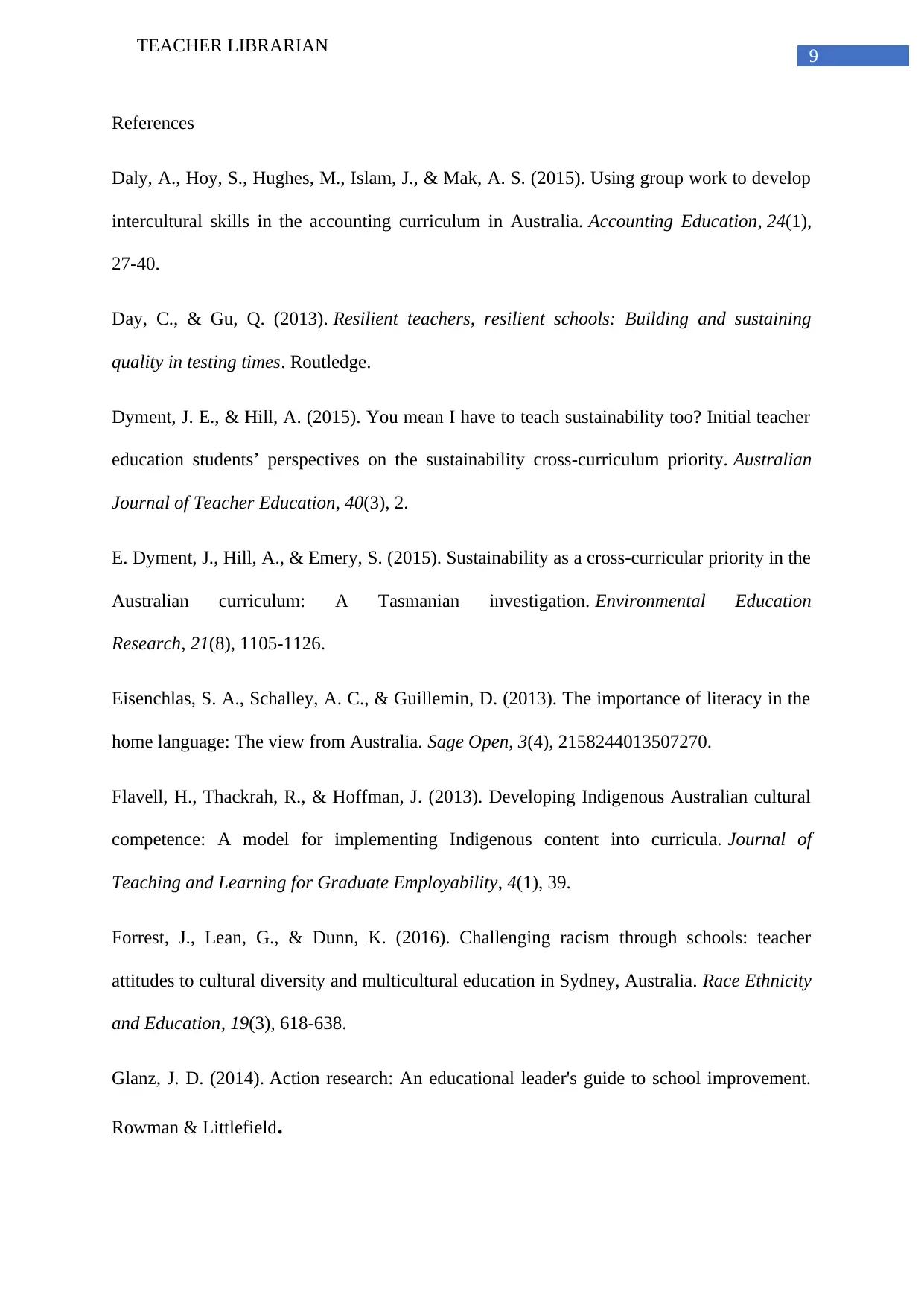
9
TEACHER LIBRARIAN
References
Daly, A., Hoy, S., Hughes, M., Islam, J., & Mak, A. S. (2015). Using group work to develop
intercultural skills in the accounting curriculum in Australia. Accounting Education, 24(1),
27-40.
Day, C., & Gu, Q. (2013). Resilient teachers, resilient schools: Building and sustaining
quality in testing times. Routledge.
Dyment, J. E., & Hill, A. (2015). You mean I have to teach sustainability too? Initial teacher
education students’ perspectives on the sustainability cross-curriculum priority. Australian
Journal of Teacher Education, 40(3), 2.
E. Dyment, J., Hill, A., & Emery, S. (2015). Sustainability as a cross-curricular priority in the
Australian curriculum: A Tasmanian investigation. Environmental Education
Research, 21(8), 1105-1126.
Eisenchlas, S. A., Schalley, A. C., & Guillemin, D. (2013). The importance of literacy in the
home language: The view from Australia. Sage Open, 3(4), 2158244013507270.
Flavell, H., Thackrah, R., & Hoffman, J. (2013). Developing Indigenous Australian cultural
competence: A model for implementing Indigenous content into curricula. Journal of
Teaching and Learning for Graduate Employability, 4(1), 39.
Forrest, J., Lean, G., & Dunn, K. (2016). Challenging racism through schools: teacher
attitudes to cultural diversity and multicultural education in Sydney, Australia. Race Ethnicity
and Education, 19(3), 618-638.
Glanz, J. D. (2014). Action research: An educational leader's guide to school improvement.
Rowman & Littlefield.
TEACHER LIBRARIAN
References
Daly, A., Hoy, S., Hughes, M., Islam, J., & Mak, A. S. (2015). Using group work to develop
intercultural skills in the accounting curriculum in Australia. Accounting Education, 24(1),
27-40.
Day, C., & Gu, Q. (2013). Resilient teachers, resilient schools: Building and sustaining
quality in testing times. Routledge.
Dyment, J. E., & Hill, A. (2015). You mean I have to teach sustainability too? Initial teacher
education students’ perspectives on the sustainability cross-curriculum priority. Australian
Journal of Teacher Education, 40(3), 2.
E. Dyment, J., Hill, A., & Emery, S. (2015). Sustainability as a cross-curricular priority in the
Australian curriculum: A Tasmanian investigation. Environmental Education
Research, 21(8), 1105-1126.
Eisenchlas, S. A., Schalley, A. C., & Guillemin, D. (2013). The importance of literacy in the
home language: The view from Australia. Sage Open, 3(4), 2158244013507270.
Flavell, H., Thackrah, R., & Hoffman, J. (2013). Developing Indigenous Australian cultural
competence: A model for implementing Indigenous content into curricula. Journal of
Teaching and Learning for Graduate Employability, 4(1), 39.
Forrest, J., Lean, G., & Dunn, K. (2016). Challenging racism through schools: teacher
attitudes to cultural diversity and multicultural education in Sydney, Australia. Race Ethnicity
and Education, 19(3), 618-638.
Glanz, J. D. (2014). Action research: An educational leader's guide to school improvement.
Rowman & Littlefield.
Paraphrase This Document
Need a fresh take? Get an instant paraphrase of this document with our AI Paraphraser
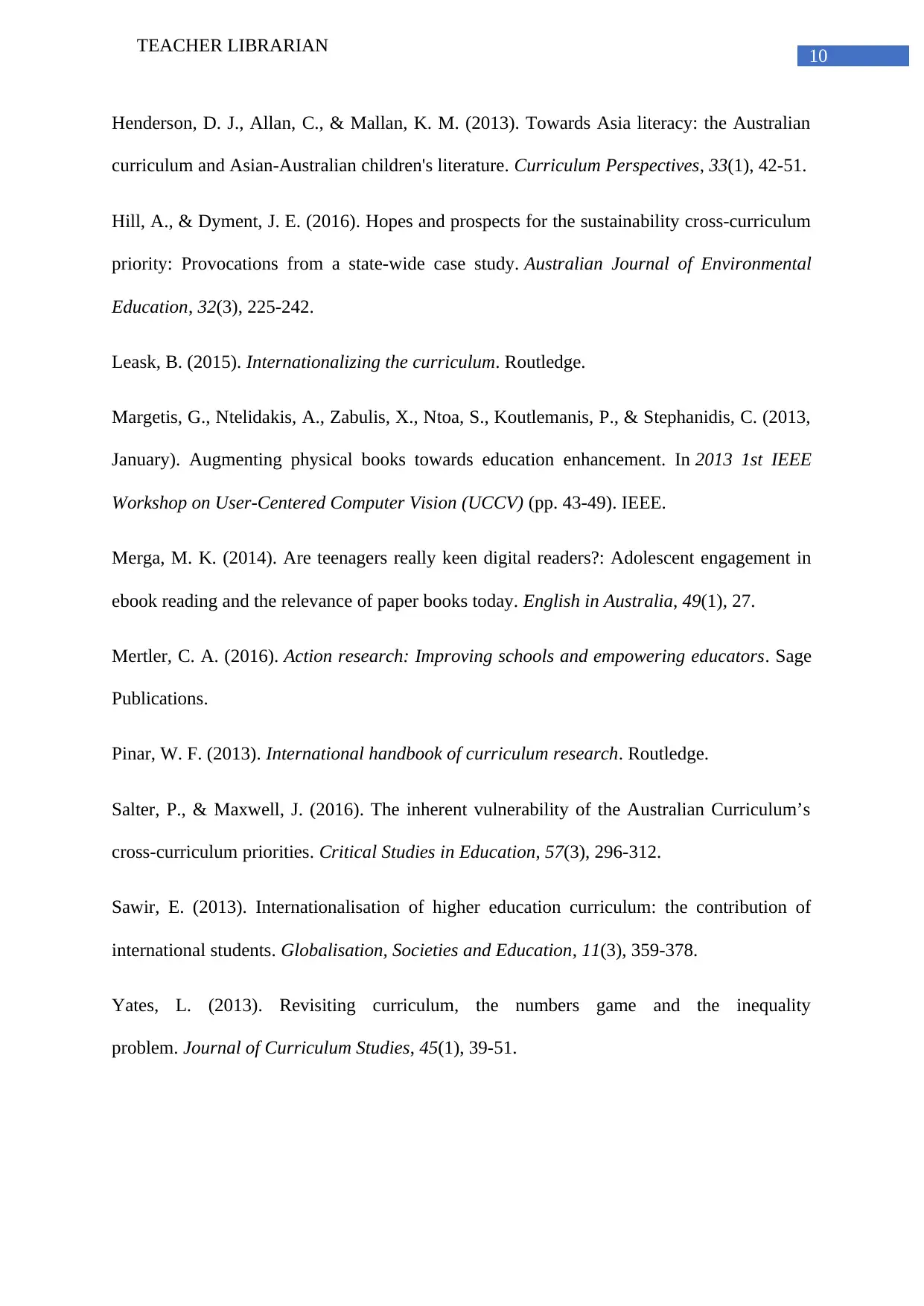
10
TEACHER LIBRARIAN
Henderson, D. J., Allan, C., & Mallan, K. M. (2013). Towards Asia literacy: the Australian
curriculum and Asian-Australian children's literature. Curriculum Perspectives, 33(1), 42-51.
Hill, A., & Dyment, J. E. (2016). Hopes and prospects for the sustainability cross-curriculum
priority: Provocations from a state-wide case study. Australian Journal of Environmental
Education, 32(3), 225-242.
Leask, B. (2015). Internationalizing the curriculum. Routledge.
Margetis, G., Ntelidakis, A., Zabulis, X., Ntoa, S., Koutlemanis, P., & Stephanidis, C. (2013,
January). Augmenting physical books towards education enhancement. In 2013 1st IEEE
Workshop on User-Centered Computer Vision (UCCV) (pp. 43-49). IEEE.
Merga, M. K. (2014). Are teenagers really keen digital readers?: Adolescent engagement in
ebook reading and the relevance of paper books today. English in Australia, 49(1), 27.
Mertler, C. A. (2016). Action research: Improving schools and empowering educators. Sage
Publications.
Pinar, W. F. (2013). International handbook of curriculum research. Routledge.
Salter, P., & Maxwell, J. (2016). The inherent vulnerability of the Australian Curriculum’s
cross-curriculum priorities. Critical Studies in Education, 57(3), 296-312.
Sawir, E. (2013). Internationalisation of higher education curriculum: the contribution of
international students. Globalisation, Societies and Education, 11(3), 359-378.
Yates, L. (2013). Revisiting curriculum, the numbers game and the inequality
problem. Journal of Curriculum Studies, 45(1), 39-51.
TEACHER LIBRARIAN
Henderson, D. J., Allan, C., & Mallan, K. M. (2013). Towards Asia literacy: the Australian
curriculum and Asian-Australian children's literature. Curriculum Perspectives, 33(1), 42-51.
Hill, A., & Dyment, J. E. (2016). Hopes and prospects for the sustainability cross-curriculum
priority: Provocations from a state-wide case study. Australian Journal of Environmental
Education, 32(3), 225-242.
Leask, B. (2015). Internationalizing the curriculum. Routledge.
Margetis, G., Ntelidakis, A., Zabulis, X., Ntoa, S., Koutlemanis, P., & Stephanidis, C. (2013,
January). Augmenting physical books towards education enhancement. In 2013 1st IEEE
Workshop on User-Centered Computer Vision (UCCV) (pp. 43-49). IEEE.
Merga, M. K. (2014). Are teenagers really keen digital readers?: Adolescent engagement in
ebook reading and the relevance of paper books today. English in Australia, 49(1), 27.
Mertler, C. A. (2016). Action research: Improving schools and empowering educators. Sage
Publications.
Pinar, W. F. (2013). International handbook of curriculum research. Routledge.
Salter, P., & Maxwell, J. (2016). The inherent vulnerability of the Australian Curriculum’s
cross-curriculum priorities. Critical Studies in Education, 57(3), 296-312.
Sawir, E. (2013). Internationalisation of higher education curriculum: the contribution of
international students. Globalisation, Societies and Education, 11(3), 359-378.
Yates, L. (2013). Revisiting curriculum, the numbers game and the inequality
problem. Journal of Curriculum Studies, 45(1), 39-51.
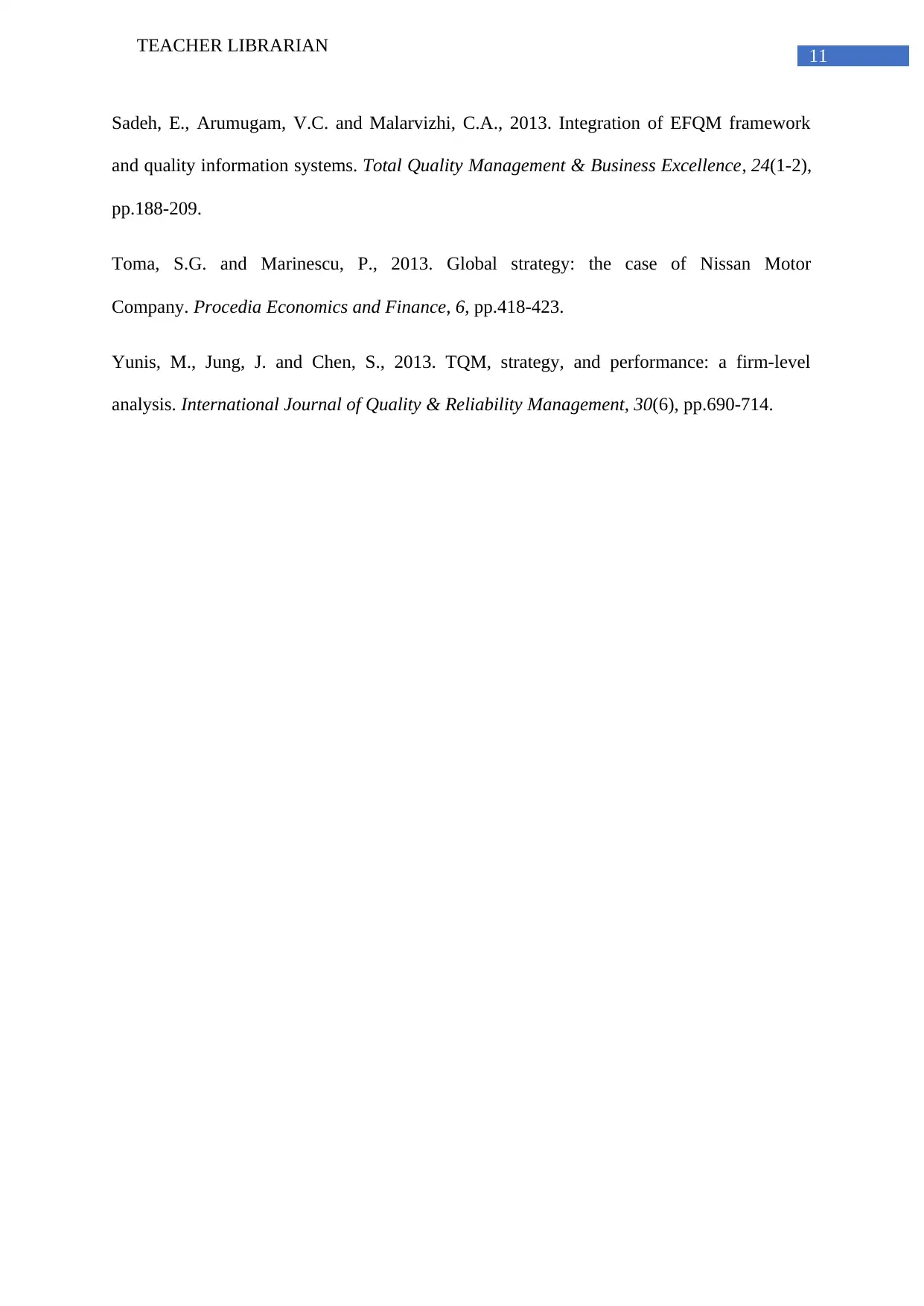
11
TEACHER LIBRARIAN
Sadeh, E., Arumugam, V.C. and Malarvizhi, C.A., 2013. Integration of EFQM framework
and quality information systems. Total Quality Management & Business Excellence, 24(1-2),
pp.188-209.
Toma, S.G. and Marinescu, P., 2013. Global strategy: the case of Nissan Motor
Company. Procedia Economics and Finance, 6, pp.418-423.
Yunis, M., Jung, J. and Chen, S., 2013. TQM, strategy, and performance: a firm-level
analysis. International Journal of Quality & Reliability Management, 30(6), pp.690-714.
TEACHER LIBRARIAN
Sadeh, E., Arumugam, V.C. and Malarvizhi, C.A., 2013. Integration of EFQM framework
and quality information systems. Total Quality Management & Business Excellence, 24(1-2),
pp.188-209.
Toma, S.G. and Marinescu, P., 2013. Global strategy: the case of Nissan Motor
Company. Procedia Economics and Finance, 6, pp.418-423.
Yunis, M., Jung, J. and Chen, S., 2013. TQM, strategy, and performance: a firm-level
analysis. International Journal of Quality & Reliability Management, 30(6), pp.690-714.
⊘ This is a preview!⊘
Do you want full access?
Subscribe today to unlock all pages.

Trusted by 1+ million students worldwide
1 out of 12
Related Documents
Your All-in-One AI-Powered Toolkit for Academic Success.
+13062052269
info@desklib.com
Available 24*7 on WhatsApp / Email
![[object Object]](/_next/static/media/star-bottom.7253800d.svg)
Unlock your academic potential
Copyright © 2020–2025 A2Z Services. All Rights Reserved. Developed and managed by ZUCOL.





